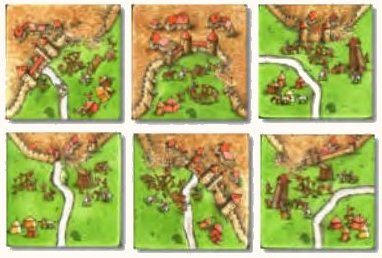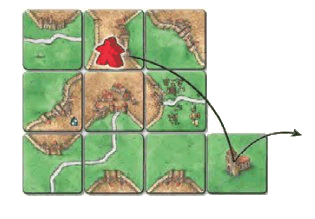Besieged City
The Cathars expansion of 4 tiles was initially released in Spielbox in 2004, and because of its rarity, it has become one of the most sought-after Carcassonne expansions.

Copyright
prevented The Cathars from being reprinted by anyone except Spielbox, so Rio Grande
Games developed Siege to be able to publish tiles with the same function in 2008. The four tiles in
Siege tiles have the same functional layout as the tiles in The Cathars, but the artwork is
entirely new. Thus, Siege is effectively a reprint of The Cathars with updated artwork. The
rules for Siege are also almost identical to those for The Cathars; the only difference
involves escape from a besieged city (see rules below).

Hans im Glück recognized the popularity of The Cathars and published The C1 Besiegers in 2013 to allow players to be able to obtain this element of Carcassonne again.
The rules are identical to those of The Cathars, but the geography of the Besiegers tiles
and the tile artwork are all new. Interestingly, the 2014 version of the Besiegers rules
includes the note: "This mini-expansion appears in the 2004 Spielbox magazine under the
name 'The Cathars' (with only 4 tiles)." This seems to indicate that this expansion is
considered a reprint rather than a new expansion, even though the tile features are
different between the two sets.

Ultimately, oldbonz made a post in Carcassonne Central to start the process of updating all of the Besieger tiles from C1 to C2.






The new land tiles should be mixed in with the other land tiles.
Except for the following rules, all rules of Carcassonne remain
the same.
Completed cities
Cities which contain Besieger tiles are said to be besieged. Whenever
a besieged city is completed during the course of play, each tile and
each pennant in that city score only 1 point instead of the usual 2.
If the city also contains a Cathedral, it scores only 2 points for
every tile instead of 3.
Note that the number of Besiegers/Cathars/Siege tiles in the city
does not matter. All besieged cities are treated the same for the
purposes of scoring, regardless of the number of besieging
tiles.
Incomplete cities at the end of the game
Should any besieged city remain incomplete at the end of the game,
(with or without a Cathedral) it scores no points during the final
scoring.
The Cathar Crusade in the 13th century was a 20-year
religious / military campaign initiated in southern France. As
the Cathars, Siege, Besiegers were adapted for the Carcassonne
game, since this was a religious campaign, it was decided that an
adjacent Monastery could be used by the followers in the city to
escape from the besieges.
Original Rules
It is possible to escape a besieged city via a neighboring cloister.
If a cloister directly borders a Besiegers or Cathars tile, even
diagonally, then at the end of a player's turn, he or she may remove
one follower from the besieged city and return it to the supply.
 RED wants to remove his knight from the
besieged city. Since a cloister is adjacent to the Besieger tile on
the right, he may remove his follower at the end of the turn.
RED wants to remove his knight from the
besieged city. Since a cloister is adjacent to the Besieger tile on
the right, he may remove his follower at the end of the turn.
Note that a cloister must be placed directly adjacent to a Besieger
tile to allow a follower to escape.
 However, RGG's rules for Siege
state that a cloister allowing escape can be placed adjacent to any
tile of a besieged city (even diagonally). For the sake of
consistency, at the beginning of the game it would be useful to
select only one of these rules when combining tiles from these sets.
Purists can choose the Besiegers/Cathars rule, as it's the German
original, although the RGG Siege rule makes escape much more
viable.
However, RGG's rules for Siege
state that a cloister allowing escape can be placed adjacent to any
tile of a besieged city (even diagonally). For the sake of
consistency, at the beginning of the game it would be useful to
select only one of these rules when combining tiles from these sets.
Purists can choose the Besiegers/Cathars rule, as it's the German
original, although the RGG Siege rule makes escape much more
viable.
Only one follower can escape a besieged city per turn. It's
irrelevant whether the followers are in the same city or different
cities.
When there is a builder double-turn, a knight can be removed from a
beseiged city in each part of the double turn.
Note: When your last knight (meeple, phantom, wagon, etc.)
has been removed from the city, your builder can also be returned
to your supply.
Question: Can I simply free a knight after a turn, if a
cloister borders [a besieged city], or do I have to build onto that
city or cloister [in the same turn]? Answer: Knights can escape when
the conditions (cloister next to a Besiegers tile) are fulfilled. A
player is not obliged to build onto the city, nor onto the cloister.
He or she must simply have a knight in the city.
|